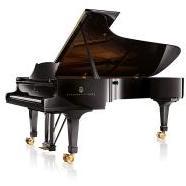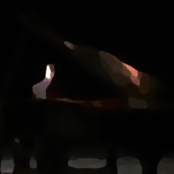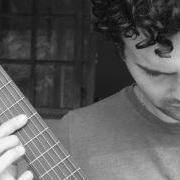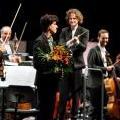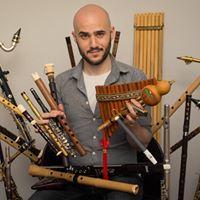Search the Community
Showing results for tags 'oboe'.
-
Hey guys! I'm getting ready to start on my longest piece to date: a 10-minute chamber concerto featuring the oboe as the soloist. Instrumentation (subject to change): Woodwinds - Oboe, Flute, Bb Clarinet, Basson, Bass Clarinet Strings - 4 Violins, 2 Violas, 2 cellos, 2 DB Brass: French Horn, 2 Trumpets I am not sure where to start, so I was hoping to see if anyone had any resources they could recommend, such as words of advice, structural advice, instrumentation, etc. Thank you
-
i invite you to listen to my oboe concerto which is my latest work, these kind of compositions i know how to do best! i hope 😉 in the italian style!
- 4 replies
-
- concerto
- baroque style
-
(and 1 more)
Tagged with:
-
I did this composition as the final exercise in the Coursera "Compose like Mozart" course.
-
I wanted to share this very simple thing I wrote thinking about things from the past and etc.... The basis was: a very singable melody, and a fixed progression: I - IV - (ii - V)/iv - iv - (ii - V)/ii - ii - (ii - V)/V - Vsus - V - I For oboe (English horn) + electric piano (mark). The one in the picture is one of my deceased dogs.... He was very big and precious, protector of babies, children, puppies and cats. But he did everything in a big way.
- 6 replies
-
- 2
-

-
- english horn
- oboe
-
(and 1 more)
Tagged with:
-

Larghetto for oboe (combining schemata and rhetorics)
Luis Hernández posted a topic in Chamber Music
Hi friends, This is an example of what I want to do in my new blog. In this little piece, there is an intertwined work of schemata and rhetoric figures. I have spoken previously about schemata, and they are notated at the bottom of the systems. Now, I have added some rhetoric figures, that will be explained in detail in the blog. Anaphora is the repetition of a structure at the beginning of several phrases. Hyperbaton is a change in the order of the notes. Chiasmus is the mirrored repetition of a motive or phrase. Pleonasm is the addition of "superfluous" elements. Anadiplosis is the repetition of a part which was the end of a phrase in the beginning of a the next. Epizeuxis is the repetition of something in the middle of a phrase Concatenation and gradation are similar to climax-anticlimax. Pathopoeia is the expression of an idea with chromaticism. [with time, I will translate into English the entries about schemata] Let me say that writing music this way is an adventure. Funny and instructive. And, surely, is the essence of baroque-galant music. And there's more to say: this is nothing "mechanical". When you get familiar with the process, it becomes natural, as it happens when you write in the romanticism style or dodecaphonic of whatever. In the end, this devices had a purpose: to convey emotions. Sorry for the engraving it's not the best, but I wanted to keep the phrases together.- 4 replies
-
- 1
-

-
- galnt style
- schemata
-
(and 3 more)
Tagged with:
-
Wienklassicist 10 - Full Score.pdfWienklassicist 10.mp3 Hi fellow composers! I'm pretty satisfied with this piece all in all, but I need help with the transition to the end where the theme comes in again. I can't find a way to make it feel natural, so I made some rubbish two bars that the violin play solo. also the preceding call and response thingy between violin I and the rest of the strings is something I'm a little unsure of. Any other comments are also interesting. Thanks and have a good day! / Olov
-
This is a piece I wrote a little while ago and forgot to post. It makes me think of my childhood home; hence the name. I know that the harmonies aren’t too advanced, and I gladly welcome advice or suggestions as to how to complicate it a little more!
- 2 replies
-
- 1
-

-
- chamber music
- oboe
-
(and 1 more)
Tagged with:
-
This is a piece I wrote recently about a nervous auditioner (I think that’s the right word) in an audition for area or district band. It is supposed to be more on the theatrical side with some instruments representing people. There are four movements, each representing a part of the audition process. I will explain each one in depth:
-
Hey, I’m new to this website but I figured it’d be a good idea to get advice from other composers since I’m almost entirely self taught with composing and I could always use advice. Anyway here’s one of my pieces. I use Finale and some of the dynamics may seem too quiet or loud for an actual player but I most likely wrote it like that for making it sound the most ‘realistic’ when Finale played it back.
-
The second movement of my piano concerto, I wrote it during the lockdown and I feel like it exemplifies my mood throughout. I'm particularly pleased with the brief piu mosso section. I wanted to upload it with note performer, although I currently don't have my finances in order. so I didn't, if I get it soon I'll re-upload it. Please let me know your thoughts, and I'm working on the final movement, as I'm not short on time.!
-
My hand at a relatively short miniature form created by another member on this forum @luderart I'll be adding some more here as I develop more confidence in writing these type of pieces. So far, this was an enjoyable exercise in brevity. Love it.
-
Hello all, Here is the first movement of my Fantasy in D Minor, scored for pairs of Oboes, Clarinets, Horns and Bassoons. It is written in sonata form, and I tried to share the material between the different instruments. It took me a long time to write - I hope you enjoy it!I - Lento.mp3
-
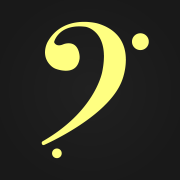
sonata Sonata for Oboe and Piano - The story of a warrior
Jean Szulc posted a topic in Chamber Music
Hello everyone! I've just posted my latest (and hopefully greatest) work yet. It's a Sonata for Oboe and Piano, which I've beew working on for the past month. The first and second movement took me 3 days to write, altought I altered them quite a bit. The last movement actually took a few weeks, as I had to experimetn with polychords (I had never used them before). Also, thank's to @Monarcheon for posting the masterclass on polychords, that's what stroke my interest on them! After listening to it various times, the image of a warrior that was cast on to an adventure, in which he met various conditions and exotic creatures really fit the mood, so I decided to name the movements accordingly. So, here's the link to it! As always, feedback is greatly apreciated. Best wishes, Jean. -
This piece was begun while I was still studying in Prague. The instrumentation is a straight-forward ode to the Baroque-style of concerto writing, having a more intimate, chamber feel. Moreover, I wanted each of the movements to say both something of the country, as well as recount one of my own memories from my time there. Each movement is therefore a dedication to a particular figure in Czechoslovak history and they move in chronological order (beginning with its independence from the Austro-Hungarian Empire under Masaryk, c. 1918). The first movement recalls a November hike in the outskirts of Prague, where it is far more rural and moderately hilly. I was with a couple of friends and we walked the path until we ended up getting lost, having taken the wrong turn. The music reflects this by consistently ‘losing its place’ and becoming diverted: phrasing is often truncated, the rhythms hesitate in precision, and the oboe frequent reaches to it's higher register in swooning melodies. The piece in essence depicts the Bohemian woods, which are culturally very important. For this reason, I chose Masaryk – the first Czechoslovak president and a symbolic ‘father of the nation’— as the dedicatee for this movement. The second movement is for pacifist teacher Přemysl Pitter, who aided young Jewish, German, and Czech children who were prosecuted/abandoned during and after the Second World War. My professor – who was transfixed on American Quakers and pacifism – had a particular affinity for Pitter, and we visited his house in Žižkov. The piece is primarily tranquil, though the central section is spritely and dance-like. The final movement is dedicated to the first president following the fall of the one-party system in the Velvet Revolution, Václav Havel, who was a playwright. During the communist rule, he was imprisoned several times for his political activities and his writings (via Samizdat). The music is frantic and, at times, scattered, with bits of material struggling to shine through. In essence, sections of the music are ‘censored,’ and themes from all three movements are combined as the music continues.
-
Here goes my new piece (inspired on Barroque Music) Instruments: Oboe Solo, Violin Solo, String Orchestra and Harpsichord if you liked, you can also hear:
- 1 reply
-
- 1
-

-
- barroque
- chamber strings
-
(and 2 more)
Tagged with:
-
Hey, guys! I just finished work on the first movement of a new sonata, this time for oboe and piano; it was a quick two days. I was first planning a piano sonata, but I shifted my mind over to a duet like this instead, a form in which I enjoy writing the most. The sonata, I plan, will have three movements, and this is only the first. It has several main key areas/significant harmonies, and all of them are in mm. 30- 31. This is a piece with a story-without-words, with many motifs depicting the motions and movements of the eponymous frogs and of flowing and dripping water. While much of the music could have been conceived of in 6/8, the music finally transforms starting in the frog dance at m. 156, wherein first the meter changes into the easiest conceptualization of the original music, then it shifts from duple into triple (i.e. the oboe's introductory line), and finally back into compound duple as its final transformation, all the while taming the bombastic eccentricity of the previous material, as well as the shifting harmonic language and chromaticism. Let me know what you think! P.S. The type-facing is elementary and it will be adjusted in the final drafting process, when the following movements are done.
-
Hello, friends! I recently joined this forum, and this is my first post here. I have been working on this piece for a little while now to use in my college application portfolios. I would love to get some feedback on it, if anyone is inclined to listen and look at it. I will be recording it next week, so anything you have to say would be great.
- 7 replies
-
- chamber music
- duets
-
(and 3 more)
Tagged with:
-
Instead of arranging a piece for a full band, I tried doing a slightly different style. Inspired by Adrian Quince, I had high woodwinds (oboe), low woodwinds (bassoon), saxophone, high brass (trumpet) and low brass (tuba). The ending still isn't completely final because I still am not sure what to do with it. Any feedback/suggestions? https://musescore.com/user/15379306/scores/3341871 small band piece.mid
-
Alto Saxophone Concertino No.1 in f minor ‘’Batterij’’, Opus 14 Dear reader / listener, I composed this concertino on the 14th of July for a national composition competition in Holland. The piece is about my black-out, which I had last school year. The composition is originally written for members of the Jong Nederlands Blazers Ensemble (Young Dutch Wind Ensemble) and me as soloist: Alto saxophone; oboe; clarinet in B-flat; horn in F; bassoon. Feedback would be very nice, because I have not received much useful feedback from the judges at the competition. Kind regards, Maarten Bauer (16). Nota bene about the video: We had to practise the composition in less than fifteen minutes, so there are some mistakes. In my opinion it still sounds better than when it is played by a computer.
- 4 replies
-
- concertino
- alto
- (and 13 more)
-
Just a simple theme fit for village music. Not too good with flutes but I hope it was done well. The biggest challenge was going from the C major scale to the E min scale, thought it would sound good together maybe. Edit: I wanted to so badly have a counter melody to the flute using the Oboe but didn't really know the correct way to do it since to me, the flute left no room for a counter (or perhaps it did but I didn't know) I find counter melodies hard to do and may need some advice on that for future reference.
- 10 replies
-
- flute piano
- spiccato strings
-
(and 2 more)
Tagged with:
-
Hey guys! So, I'm a little mentally exhausted -- I'm just after writing nine pieces in the past three days (which will all be uploaded soon.) This is my first true chamber sonata for oboe and piano, and I hope you guys enjoy. I really enjoy writing in this form, so let me know what you think and thanks for the help.
-
I thought you guys might be interested in my new series! I'm creating 2-3 minute videos about writing for every member of the woodwind family. I also am more than happy to answer any questions that are posted on the video. If you're interested, here's the playlist:
-
My first orchestral piece finally done! Opus 12 is written for modified orchestral ensemble consisting of : Piano, Woodwinds : flute, oboe, A clarinet Brass : French horn Percussion instruments : glockenspiel, vibraphone, tubular bells, triangle Strings : violins 1, violins 2, violas, violoncellos and contrabasses. and harp. Composition consists of first part (moderato - E major/C sharp minor), second part (F major/D minor) and third part - modified first part. Since I'm a complete amateur high school student, any helpful hints and comments are very welcomed! Score in PDF format coming soon. For more music please visit : https://www.reverbnation.com/mademoisellelilaclucrezia
- 4 replies
-
- e major
- vibraphone
- (and 25 more)
-
When I'm composing for full orchestra, I often find that I have trouble writing parts for the Woodwind section. These are some of my favorite instruments as far as their sound goes, but I just can't seem to write very "elaborate" or "high quality" sounding parts for them. Any tips or tricks would be appreciated. Thanks!

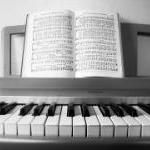
(1).thumb.jpg.1336d093d112555a132162dfc44a4d71.jpg)




